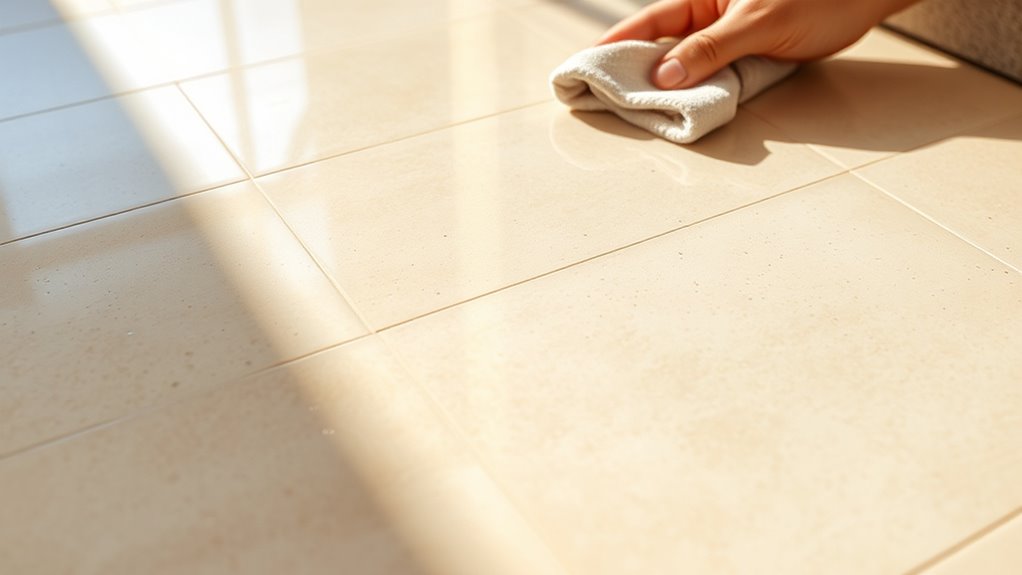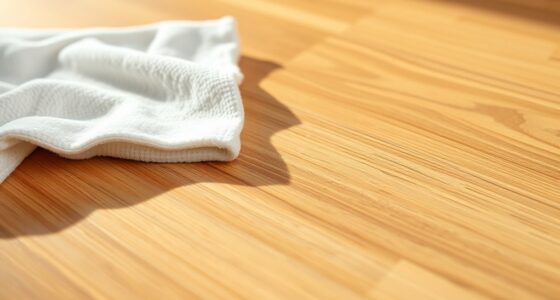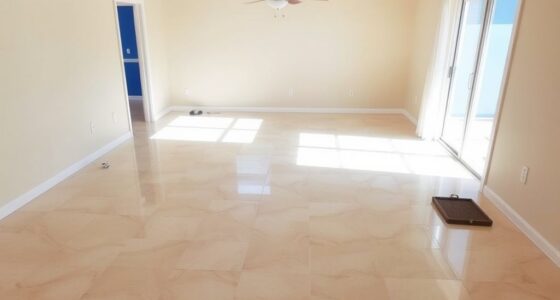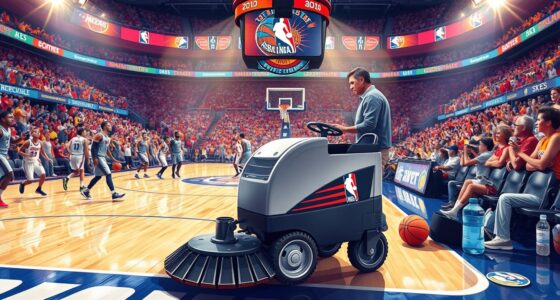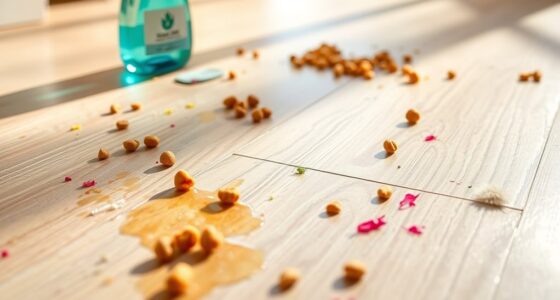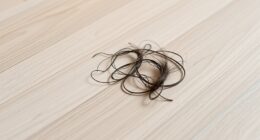Before you mop your tile floors, make sure to remove loose dirt and debris by sweeping or vacuuming with a soft brush attachment. Use a microfiber mop head to prevent scratches, and keep it damp—not soaked—using clean water or a gentle cleaning solution. Protect furniture by attaching pads to legs and lift heavy items instead of dragging them. These simple steps help keep your tiles pristine and scratch-free—continue to discover more tips for maintaining your floors.
Key Takeaways
- Use a soft microfiber mop head to prevent scratching the tile surface.
- Ensure mop fibers are clean and free of grit before starting to avoid abrasions.
- Sweep or vacuum thoroughly to remove loose dirt and debris that can cause scratches.
- Attach protective pads to furniture legs to prevent scratches when moving items on the floor.
- Dampen the mop lightly with water or tile-safe cleaner, avoiding excessive moisture that can damage grout.
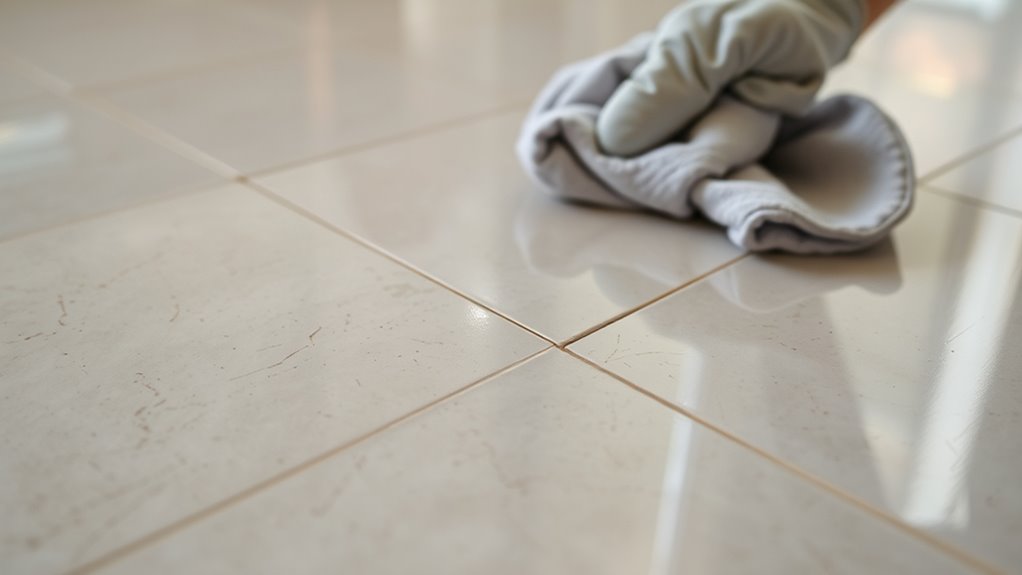
Scratches on tile floors can quickly ruin their appearance and diminish your home’s overall look. Before you reach for your mop, it’s vital to take a few steps to prevent these unsightly marks. One of the most effective ways to do this is by paying close attention to your mop selection. Not all mops are created equal, and some can do more harm than good. For tile floors, opt for a soft, microfiber mop head that gently lifts dirt and debris without scratching the surface. Avoid using abrasive scrub brushes or rough cleaning pads that can cause micro-scratches over time. The right mop helps you clean effectively while protecting your tiles from unnecessary damage.
Choose a soft microfiber mop to clean tile floors without causing scratches.
Another essential step is to prepare your cleaning tools properly. Inspect your mop and ensure the head is clean and free of grit. Dirt and tiny particles trapped in the mop fibers can act like sandpaper, scratching your tiles as you mop. Rinse or change the water frequently during cleaning to keep debris from settling back onto the floor. Additionally, consider investing in protective pads or covers for your mop. These pads act as a buffer, reducing friction between the mop and the tile surface. Protective pads are inexpensive but can make a big difference in preserving your flooring’s pristine condition over time.
You also want to be mindful of the objects you use to move across your tile floor. Furniture legs, shoes, and other items can cause scratches if dragged carelessly. To minimize this risk, attach protective pads to the bottom of furniture legs and try to lift items instead of sliding them. When moving furniture or heavy objects, take extra care and avoid dragging them across the surface. This simple step shields your tiles from scratches that can be difficult and costly to repair.
Before you start mopping, sweep or vacuum the floor thoroughly to remove loose dirt and debris. This prevents particles from being pressed into the tile surface during cleaning. Use a soft-bristled broom or a vacuum with a brush attachment to gently pick up dirt without scratching. Once debris is cleared, dampen your microfiber mop with clean water or a gentle cleaning solution specifically formulated for tile floors. Avoid soaking the mop excessively, as too much water can seep into grout lines or cause slipping hazards. Additionally, understanding the role of surface protection in maintaining your tiles can help prevent scratches and extend the longevity of your flooring.
Frequently Asked Questions
Can Certain Cleaning Tools Cause More Scratches on Tiles?
Yes, certain cleaning tools can cause more scratches on tiles. Using abrasive cleaners or rough scrubbing brushes damages the tile surface over time. These tools can scratch or dull the finish, especially if you apply too much pressure. To protect your tiles, opt for soft cloths or non-abrasive sponges, and avoid harsh cleaners. Gentle, proper tools help keep your tiles looking new and scratch-free.
Are There Specific Cleaning Products That Prevent Tile Scratches?
Imagine it’s 1776, and you’re cleaning with gentle care. Yes, there are specific cleaning products that prevent tile scratches: look for pH balanced cleaners that won’t harm your tiles’ surface. Pair them with microfiber mops, which are soft and effective at trapping dirt without scratching. These tools and products work together to keep your tile floors pristine, ensuring they stay beautiful and scratch-free longer.
How Often Should I Inspect for Scratches on My Tile Floors?
You should inspect your tile floors regularly, ideally once a week, as part of your tile maintenance routine. During your floor inspection, look for any scratches, chips, or wear that might need attention. Consistent inspection helps catch damage early, preventing further issues. Keeping up with this routine guarantees your tile floors stay pristine, and addressing scratches quickly maintains their appearance and longevity.
Do Different Tile Materials Require Different Scratch Prevention Methods?
You might think all tile materials need the same scratch prevention techniques, but that’s not true. Different tiles, like ceramic, porcelain, or natural stone, require tailored tile maintenance. For example, softer tiles need gentler cleaning tools, while harder tiles are more resistant. Knowing your tile type helps you choose the right scratch prevention techniques, ensuring your floors stay pristine longer. Always check manufacturer guidelines for specific care instructions.
Can Sealing Tiles Help Reduce Scratches During Mopping?
Sealing tiles can definitely help reduce scratches during mopping. Applying a sealant creates a protective coating that shields the surface from abrasive particles and dirt that cause scratches. Regularly reapplying sealant maintains this barrier, keeping your tiles looking new longer. Use a proper sealant application method and choose a quality protective coating to guarantee your tiles stay scratch-free, even through frequent cleaning.
Conclusion
Just like a wizard wards off dark forces, taking these simple steps shields your tile floors from scratches. With a little care, you can keep your floors gleaming like a treasure chest, untouched by the wear and tear of daily life. Remember, a proactive approach now prevents future regrets—think of it as your secret spell for lasting beauty. So, gear up and protect your floors today; their shine depends on your magic touch.
